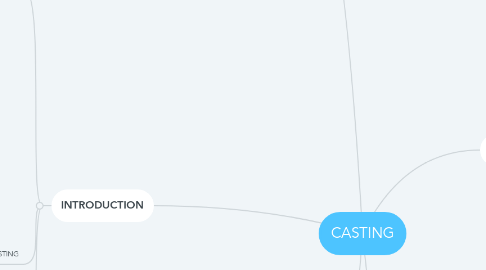
1. INTRODUCTION
1.1. MOLD
1.1.1. The mold contains a cavity whose geometry determines the shape of the cast part.
1.1.2. 1) Open Mold Is the liquid metal is simply poured until it fillsthe open cavity.
1.1.3. 2) Closed Mold is a passageway called the gating system, is provided to permit the molten metal to flow from outside the mold into the cavity.
1.1.4. 3) Expendable Mold is that the mold in which the molten metal solidifies must be destroyed in order to remove the casting.
1.1.5. 4) Permanent Mold is one that can be used over and over to produce many castings.
1.2. TYPES OF CASTING
1.2.1. 1)Sand Casting is s a metal casting process characterized by using sand as the mold material
1.2.2. 2) Semi-permanent Mold Casting is The Semi-Permanent Mold process requires both metal dies and sand cores to create internal cavities for alloy flow for specific internal features. This method enhances product strength as compared to sand casting but also allows intricate passages to be created.
1.2.3. 3) Permanent Mold Casting is a metal casting process that employs reusable molds, usually made from metal. The most common process uses gravity to fill the mold.
1.2.4. 4)Plaster Mold Casting is a metalworking casting process similar to sand casting except the molding material is plaster of Paris instead of sand
1.2.5. 5)Investment Mold Casting is an industrial process based on lost-wax casting, one of the oldest known metal-forming techniques. The term "lost-wax casting" can also refer to modern investment casting processes.
1.2.6. 6) Die Casting is a metal casting process that is characterized by forcing molten metal under high pressure into a mold cavity
1.3. Type of general process
1.3.1. Maching
1.3.2. Joining
1.3.3. Forming
1.3.4. Costing
2. DEFINITION
2.1. Casting is a process in which molten metal flows by gravity or other force into a mold where it solidifies in the shape of the mold cavity
3. PERMENANT AND EXPENANDABLE MOLD
3.1. SAND CASTING
3.1.1. DEFINITION
3.1.1.1. The sand casting process involves the use of a furnace, metal, pattern, and sand mold
3.1.2. PROCESS CYCLE
3.1.2.1. 1)mold-making
3.1.2.2. 2) clamping
3.1.2.3. 3) pouring
3.1.2.4. 4)cooling
3.1.2.5. 4)removal
3.1.2.6. 5)trimming
3.2. SHELL MOLD CASTING
3.2.1. DEFINITION
3.2.1.1. Shell mold casting is a metal casting process similar to sand casting, in that molten metal is poured into an expendable mold
3.2.2. PROCESS CYCLE
3.2.2.1. 1) Pattern creation
3.2.2.2. 2) mold creation
3.2.2.3. 3) mold assembly
3.2.2.4. 4) pouring
3.2.2.5. 5) cooling
3.2.2.6. 6) casting removal
3.3. CENTRIFUGAL CASTING
3.3.1. MEANING
3.3.1.1. Centrifugal casting, sometimes called rotocasting, is a metal casting process that uses centrifugal force to form cylindrical parts.
3.3.2. PROCESS CYCLE
3.3.2.1. 1)Mold preparation
3.3.2.2. 2)Pouring
3.3.2.3. 3)CoolingPROCESS
3.3.2.4. 4)Casting removal
3.3.2.5. 5)Finishing
3.4. DIE CASTING
3.4.1. MEANING
3.4.1.1. Die casting is a manufacturing process that can produce geometrically complex metal parts through the use of reusable molds, called dies.
3.4.2. PROCESS CYCLE
3.4.2.1. 1) Clamping
3.4.2.2. 2) Injection
3.4.2.3. 3)Cooling
3.4.2.4. 4)Ejection
3.4.2.5. 5)Trimming
3.5. INVESTMENT CASTING
3.5.1. DEFINITION
3.5.1.1. Investment casting is one of the oldest manufacturing processes, dating back thousands of years, in which molten metal is poured into an expendable ceramic mold
3.5.2. PROCESS CYCLE
3.5.2.1. 1) Pattern creation
3.5.2.2. 2) Mold creation
3.5.2.3. 3) Pouring
3.5.2.4. 4)Cooling
3.5.2.5. 5)Casting removal
3.5.2.6. 6)Finishing
4. FOUNDARY PRACTICE
4.1. FURNACE TYPE
4.1.1. ELECTRIC ARC FURNACES (EAF)
4.1.2. INDUCTION FURNACES
4.1.3. CUPOLAS
4.1.4. DIRECT FUEL-FIRED FURNACES
4.1.5. CRUCIBLE FURNACES
4.2. POURING PRACTICES
4.2.1. STEPS :
4.2.1.1. 1. CHECK OUT THE FURNACE.
4.2.1.2. 2. SET A REFRACTORY BRICK IN THE MIDDLE OF THE INSIDE AS SHEFT WHICH WE WILL PLACE THE CRUCIBLE ONTO.
4.2.1.3. 3. GET A FULL TANK OF PROPANE.
4.2.1.4. 4. SCREW IN THE GAS LINE TO THE PROPANE TANK
4.2.1.5. 5. OPEN THE PROPANE TANK WITH THE VALUE ON TOP THE OPEN THE REGULAR AND KEEP IN ON HIGH.
4.2.1.6. 6. OPEN THE LINE VALUE.
4.2.1.7. 7. LIGHT THE FIRE WITH OPENED GAS LINE AND CLODSED VENTURE AIR VENT LID.
4.2.1.8. 8. USE A MATCH AND THROW IT IN FURNACE.
4.2.1.9. 9. PLUG IN THE MOTOR WITH THE AIR VENT LID.
4.2.1.10. 10. GENTLY OPENED THE VINT LID.
4.2.1.11. 11. USE ALUMINIUM SCRAPS.
4.2.1.12. 12. ARRANGED SMALLER PIECES AS IT IS MUCH FASTERMELTING THEN A BIG CHUNK.
4.2.1.13. 13. USE A METAL POLE TO CLOSE THE FURNACE LID FROM THE SIDES.
5. Quality of Casting
5.1. Defect type
5.1.1. Misruns
5.1.2. Cold Shuts
5.1.3. Shrinkage cavity
5.1.4. Microporosity
5.1.5. Hot tearing
5.1.6. Cold shots
5.2. Inspection
5.2.1. Casting finishing
5.2.2. Dimensional Accuracy
5.2.3. Casting Soundness
5.2.4. Casting Soundness
5.2.5. Chemical composition
